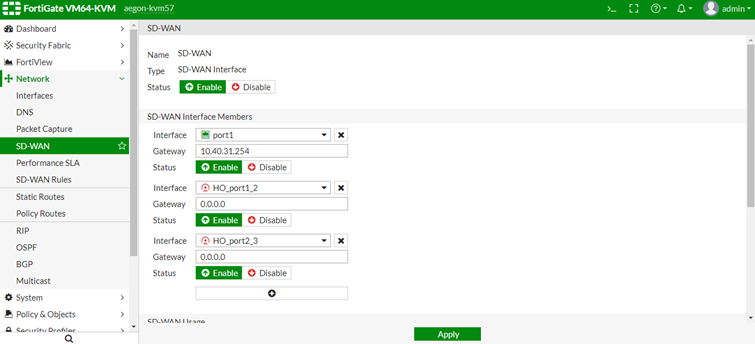- Forums
- Knowledge Base
- Customer Service
- FortiGate
- FortiClient
- FortiAP
- FortiAnalyzer
- FortiADC
- FortiAuthenticator
- FortiBridge
- FortiCache
- FortiCarrier
- FortiCASB
- FortiConnect
- FortiConverter
- FortiCNP
- FortiDAST
- FortiDDoS
- FortiDB
- FortiDNS
- FortiDeceptor
- FortiDevSec
- FortiDirector
- FortiEDR
- FortiExtender
- FortiGate Cloud
- FortiGuard
- FortiHypervisor
- FortiInsight
- FortiIsolator
- FortiMail
- FortiManager
- FortiMonitor
- FortiNAC
- FortiNAC-F
- FortiNDR (on-premise)
- FortiNDRCloud
- FortiPAM
- FortiPortal
- FortiProxy
- FortiRecon
- FortiRecorder
- FortiSandbox
- FortiSASE
- FortiScan
- FortiSIEM
- FortiSOAR
- FortiSwitch
- FortiTester
- FortiToken
- FortiVoice
- FortiWAN
- FortiWeb
- Wireless Controller
- RMA Information and Announcements
- FortiCloud Products
- ZTNA
- 4D Documents
- Customer Service
- Community Groups
- Blogs
- Fortinet Community
- Knowledge Base
- FortiGate
- Troubleshooting Tip: SD-WAN performance SLA for IP...
- Subscribe to RSS Feed
- Mark as New
- Mark as Read
- Bookmark
- Subscribe
- Printer Friendly Page
- Report Inappropriate Content
Description
This article describes how to fix an issue where the SD-WAN performance SLA shows as 'down' by adding the VPN interface to the SD-WAN and how to configure the SD-WAN performance SLA for the VPN interface.
Scope
Instructions differ between FortiOS 6.4 and above or versions before FortiOS 6.4.
Solution
After FortiOS 6.4
In FortiOS 6.4 and above, there is a wizard to facilitate easy VPN creation under the SD-WAN zone. See the following article:
Technical Tip: Configure IPsec VPN with SD-WAN - Fortinet Community.
Before FortiOS 6.4
Adding the VPN interfaces to the SD-WAN is necessary to load balance the remote network Traffic.
After adding the VPN interface to the SD-WAN, when the performance SLA is created for VPN interface, the performance SLA status shows as 'down'.
However, the VPN tunnel status shows as 'up' in the IPsec monitor:


dia vpn tunnel list
name=HO_port1_2 ver=1 serial=1 10.40.16.57:0->10.40.16.20:0
bound_if=3 lgwy=static/1 tun=intf/0 mode=auto/1 encap=none/0
proxyid_num=1 child_num=0 refcnt=20 ilast=0 olast=0 ad=/0
stat: rxp=352 txp=453 rxb=42240 txb=27180
dpd: mode=on-demand on=1 idle=20000ms retry=3 count=0 seqno=5
natt: mode=none draft=0 interval=0 remote_port=0
proxyid=HO_port1_2 proto=0 sa=1 ref=2 serial=2
src: 0:172.31.192.0/255.255.240.0:0
dst: 0:172.31.128.0/255.255.240.0:0
SA: ref=3 options=10226 type=00 soft=0 mtu=1438 expire=42225/0B replaywin=2048
seqno=1c6 esn=0 replaywin_lastseq=00000161 itn=0
life: type=01 bytes=0/0 timeout=42901/43200
dec: spi=e04e9478 esp=aes key=16 73cb7c9658e2b3bf3f9eddbf3e966514
ah=sha1 key=20 1c990b12c0ef9df9721f550924cc69e2ceadcbcc
enc: spi=276713b0 esp=aes key=16 83199cc34061a388045e59a157827281
ah=sha1 key=20 6ebe8070d5f7105ec4a70da6eb4e1e467a701463
dec:pkts/bytes=352/21120, enc:pkts/bytes=453/54360
------------------------------------------------------
name=HO_port2_3 ver=1 serial=2 10.40.48.57:0->10.40.48.20:0
bound_if=4 lgwy=static/1 tun=intf/0 mode=auto/1 encap=none/0
proxyid_num=1 child_num=0 refcnt=17 ilast=0 olast=0 ad=/0
stat: rxp=343 txp=443 rxb=41160 txb=26580
dpd: mode=on-demand on=1 idle=20000ms retry=3 count=0 seqno=4
natt: mode=none draft=0 interval=0 remote_port=0
proxyid=HO_port2_3 proto=0 sa=1 ref=2 serial=2
src: 0:172.31.192.0/255.255.240.0:0
dst: 0:172.31.128.0/255.255.240.0:0
SA: ref=3 options=10226 type=00 soft=0 mtu=1438 expire=42224/0B replaywin=2048
seqno=1bc esn=0 replaywin_lastseq=00000158 itn=0
life: type=01 bytes=0/0 timeout=42897/43200
dec: spi=e04e9479 esp=aes key=16 02b54e277607488456b277146f4d1429
ah=sha1 key=20 eaf940619730b89e85224178d7f2de33c3550e9e
enc: spi=276713b1 esp=aes key=16 9007a2942009fae3673649b9d87efe60
ah=sha1 key=20 36d1fa1945112b4baa003b6610d562608e093f07
dec:pkts/bytes=343/20580, enc:pkts/bytes=443/53160
dia sniffer packet any "host 172.31.128.20 and icmp" 4
interfaces=[any]
filters=[host 172.31.128.20 and icmp]
0.630359 HO_port1_2 out 10.40.16.57 -> 172.31.128.20: icmp: echo request
0.630388 HO_port2_3 out 10.40.16.57 -> 172.31.128.20: icmp: echo request
1.640399 HO_port1_2 out 10.40.16.57 -> 172.31.128.20: icmp: echo request
1.640444 HO_port2_3 out 10.40.16.57 -> 172.31.128.20: icmp: echo requestFlow filter logs shows 'No matching IPsec selector, drop'.
id=20085 trace_id=3 func=print_pkt_detail line=5517 msg="vd-root:0 received a packet(proto=1, 10.40.16.57:257->172.31.128.20:2048) from local. type=8, code=0, id=257, seq=50."
id=20085 trace_id=3 func=resolve_ip_tuple_fast line=5597 msg="Find an existing session, id-00001308, original direction"
id=20085 trace_id=3 func=ipsecdev_hard_start_xmit line=692 msg="enter IPsec interface-HO_port1_2"
id=20085 trace_id=3 func=ipsec_common_output4 line=804 msg="No matching IPsec selector, drop" <-----
id=20085 trace_id=4 func=print_pkt_detail line=5517 msg="vd-root:0 received a packet(proto=1, 10.40.16.57:258->172.31.128.20:2048) from local. type=8, code=0, id=258, seq=33."
id=20085 trace_id=4 func=resolve_ip_tuple_fast line=5597 msg="Find an existing session, id-0000130a, original direction"
id=20085 trace_id=4 func=ipsecdev_hard_start_xmit line=692 msg="enter IPsec interface-HO_port2_3"
id=20085 trace_id=4 func=ipsec_common_output4 line=804 msg="No matching IPsec selector, drop" <----- Solution.

A simple ping test with a source defined as an IPsec VPN tunnel IP should make it clear whether the destination server is reachable through that interface.
exe ping-options source 10.10.10.2
exe ping 192.168.1.20
PING 192.168.1.20 (192.168.1.20): 56 data bytes
64 bytes from 192.168.1.20: icmp_seq=0 ttl=255 time=2.2 ms
64 bytes from 192.168.1.20: icmp_seq=1 ttl=255 time=0.9 ms
64 bytes from 192.168.1.20: icmp_seq=2 ttl=255 time=0.3 ms
64 bytes from 192.168.1.20: icmp_seq=3 ttl=255 time=0.5 ms
64 bytes from 192.168.1.20: icmp_seq=4 ttl=255 time=0.7 ms
--- 192.168.1.20 ping statistics ---
5 packets transmitted, 5 packets received, 0% packet loss
round-trip min/avg/max = 0.3/0.9/2.2 ms
Before FortiOS 6.4:
To solve this issue, configure a source IP for the VPN interface in SD-WAN settings.
Add the FortiGate local interface IP as a source IP for the VPN in SD-WAN and make sure that it is part of the phase2 selectors.
config system virtual-wan-link
config members
edit <id>
set source x.x.x.x <----- Lan interface IP.
next
end
config system virtual-wan-link
1 port1
2 HO_port1_2
3 HO_port2_3
4 port2(members)
edit 3
dia sniffer packet any "host 172.31.128.20 and icmp" 4
interfaces=[any]
filters=[host 172.31.128.20 and icmp]
1.679274 HO_port1_2 out 172.31.192.57 -> 172.31.128.20: icmp: echo request
1.679735 HO_port1_2 in 172.31.128.20 -> 172.31.192.57: icmp: echo reply
1.799248 HO_port2_3 out 172.31.192.57 -> 172.31.128.20: icmp: echo request
1.799707 HO_port2_3 in 172.31.128.20 -> 172.31.192.57: icmp: echo reply

The Fortinet Security Fabric brings together the concepts of convergence and consolidation to provide comprehensive cybersecurity protection for all users, devices, and applications and across all network edges.
Copyright 2024 Fortinet, Inc. All Rights Reserved.